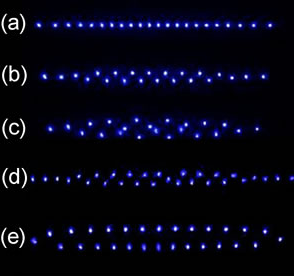Members Login

Channels
Special Offers & Promotions
Andor iXon Ultra 897 Camera Probes Moments After Big Bang
Kibble-Zurek mechanism demonstrated in laboratory system with laser-cooled ion Coulomb crystals
 The Andor iXon Ultra 897 EMCCD camera has been used by an international team of scientists to probe the nature of the symmetry-breaking phase transitions that began the process of creating our universe – the Kibble-Zurek mechanism. Most cosmological scientists agree that within less than a billionth of a second of the Big Bang, the young universe had to ‘decide’ which new state to adopt and, everywhere that individual areas could not communicate their decisions to each other, topological defects occurred that led to the creation of the galaxies and solar systems we see today.
The Andor iXon Ultra 897 EMCCD camera has been used by an international team of scientists to probe the nature of the symmetry-breaking phase transitions that began the process of creating our universe – the Kibble-Zurek mechanism. Most cosmological scientists agree that within less than a billionth of a second of the Big Bang, the young universe had to ‘decide’ which new state to adopt and, everywhere that individual areas could not communicate their decisions to each other, topological defects occurred that led to the creation of the galaxies and solar systems we see today.
The Big Bang is not an experiment that can be repeated. However, the multinational team working with Dr Tanja Mehlstaeubler of the Physikalisch-Technische Bundesanstalt (PTB) in Germany has demonstrated atomic-scale topological defects under controlled laboratory conditions for the first time. They used laser-cooled ions in so-called "ion Coulomb crystals" to optically detect errors in the spatial structure caused by the breakdown of symmetry when the particles were unable to communicate with each other. Key to the detection system was the overclocked speed performance of the iXon Ultra 897 camera from Andor.
Reporting their results in Nature Communications, the team from PTB, Los Alamos National Laboratory, the University of Ulm, and the Hebrew University of Jerusalem, trapped ytterbium ions in radio-frequency ion traps at ultra-high vacuum and laser-cooled them down to a few millikelvin. The positively-charged ions repel each other inside the trap and, at such ultra-low temperatures, take on a crystalline structure – linear (a), two-dimensional zigzag (b) or three-dimensional helix (c). However, if the parameters of the trap enclosure are then varied faster than the speed of sound in the crystal, irregularities occur while the ions seek a new equilibrium (d and e).
According to Andor’s Colin Duncan, “This team has shown for the first time that the Kibble-Zurek mechanism can be demonstrated in a relatively simple optical experiment using laser-cooled ion Coulomb crystals. The resulting topological defects depend on the speed at which changes occur and the spontaneous re-orientation of the Coulomb crystal follows the same rules as those describing the early universe after the Big Bang. Capturing these topological defects in the laboratory with our high-speed iXon Ultra 897 camera opens up new investigational possibilities for quantum phase transitions and detailing the non-equilibrium dynamics of complex systems.”
The Andor iXon Ultra 897 camera uses a back-illuminated 512 x 512 frame transfer sensor and overclocks readout to 17 MHz, pushing speed performance to an outstanding 56 fps (full frame) and facilitating a new level of temporal resolution, ideal for speed challenged low-light applications such as super-resolution microscopy, single molecule tracking, ion signalling, cell motility, single photon counting, lucky astronomy and adaptive optics. Ultimate sensitivity is attained through deep thermoelectric cooling down to -100°C and the unit boasts industry-lowest clock induced charge noise. The iXon Ultra 897 also offers direct raw data access for on the fly processing while EMCCD and conventional CCD readout modes provide heightened application flexibility.
more news from andor technology
Media Partners


